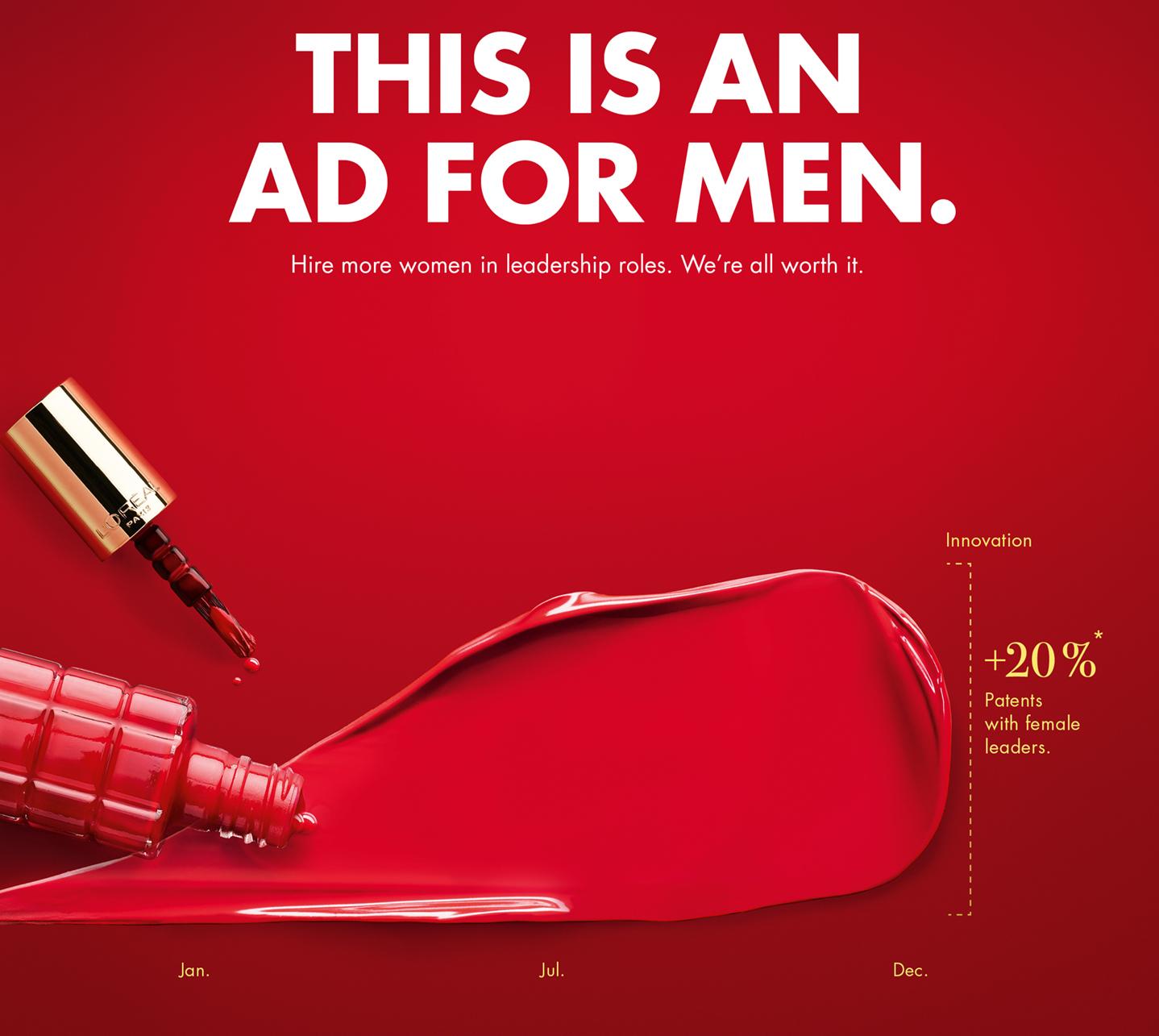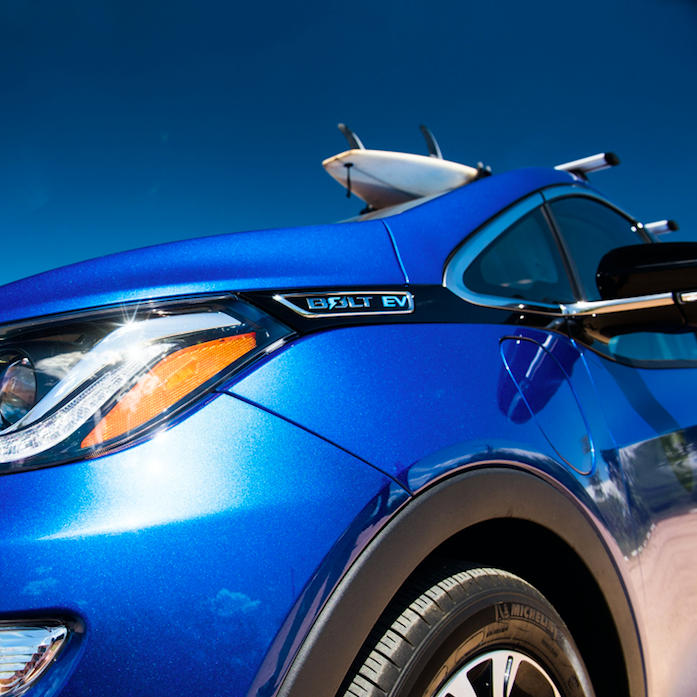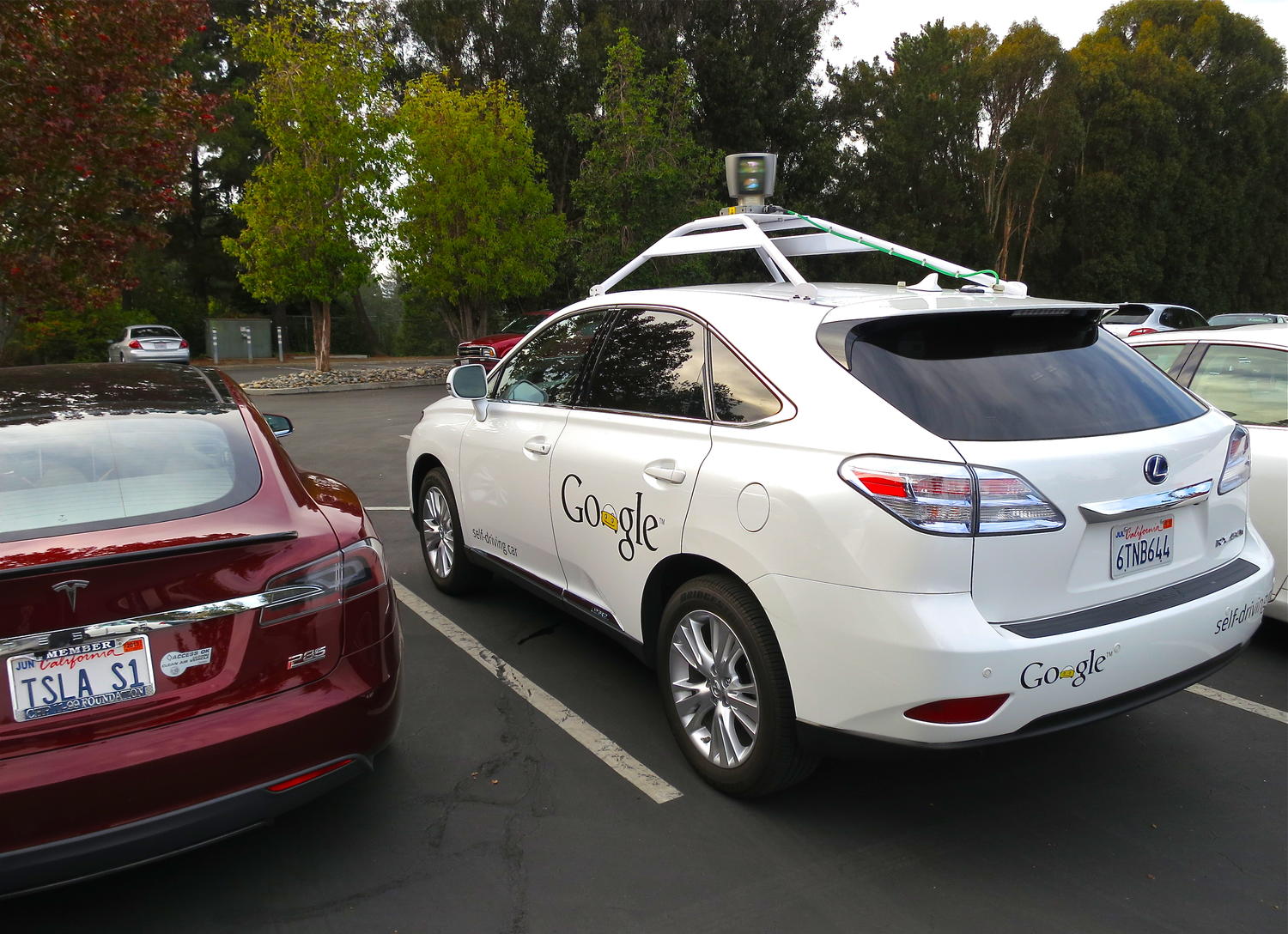L’Oreal Advertises Gender Diversity ‘Because Women are Worth It'


L’Oreal recently launched a series of advertisements that showcase its cosmetics as a way to emphasize the importance of gender diversity within companies' management ranks.
As reported in several publications, L’Oreal recently launched a series of advertisements that showcase creative interpretations of its products as a measurement of the power of female leaders. The displays are based on research that L’Oreal conducted with the advertising firm McCann Worldgroup Deutchland in Germany.
Among the various messages, one ad uses varying lipstick heights as a bar graph comparing the number of women in a company’s leadership with performance and profitability. The graph’s message is clear: There is a strong positive correlation between the percentage of female leaders of a company and its revenues. According to McCann’s research, as cited by The Drum, companies with 30 percent female leaders can gain an increase of 15 percent in revenues compared to peer organizations with a dearth of women in leadership roles. The gist is that female leaders bring more to the table beyond simply diversifying a firm’s workforce numbers.

“What women lacked in numbers they more than made up for in results, significantly outperforming their male peers on occasions where they do reach the top,” wrote The Drum’s John Glenday.
The advertisement reflects L’Oreal’s statement earlier this year that it has identified gender equality as a long-term goal. To keep itself on track, the company says it undergoes regular audits by two separate independent gender equality organizations. These groups’ audits evaluate the hiring policies and staff at all L’Oreal subsidiaries.
It’s important to see that women do more than fill a quota when they are elected to leadership positions. A 2017 report by Morgan Stanley found that more women in business translates to improvements across the board: in productivity, employee retention, innovation and decision-making. Firms that properly utilize women’s potential claim better team decisions and progress toward new product innovation. Women also know how to appeal to other women, which widens a firm’s customer base, according to this survey.
More organizations are recognizing L’Oreal’s commitment to gender equality. Bloomberg listed the company as one of 230 firms on its most recent equality index. This index is a standardized measure of gender diversity on an international scale. Companies that make the list have demonstrated a commitment to equality and empowering women in their ranks, according to Bloomberg. Stockholders are inclined to invest in companies listed on the index with the idea that an increase in contributions by female employees and leaders can lead to more profitable companies. There is a strong positive relationship between gender diversity in a firm and return on equity. These firms that place a priority on gender diversity manage to achieve higher rates of return with lower volatility, making them an attractive addition to an investor’s portfolio.
The benefits of gender diversity are seen throughout a company’s organizational structure. For example, a Massachusetts Institute of Technology economist tracked the revenues and survey results of a large international firm over eight years. The study found significant differences in the performance of solely male or female offices and gender-balanced offices. An equal gender split may lead to a 41 percent increase in revenue, which can be explained with the various skills and experiences that a diverse workforce offers. This added value is a problem-solving resource and could lead a to an office to function even better than one lacking gender parity.
For the past two decades, women have outpaced men in completing higher education degrees. Nevertheless, the joint L’Oreal-McCann study in Germany found that a whopping 91.4 percent of leadership positions are still held by men. Although women comprise a little over half the global population, women represent only a third of all employees worldwide and a quarter of business management roles. The limited number of female leaders results in over half of the world’s population relegated to only a tiny voice in corporate boardrooms. If we are to achieve equality, women must be empowered in their workplaces to contribute their ideas to solving business challenges.
Image credit: McCann Worldgroup Deutchland/Facebook
The U.S. Is Losing the Global EVs Manufacturing Race


America’s foothold in EV production should bode well for the future, but in fact, U.S. automakers are already losing the manufacturing battle when it comes to electric cars.
If you were asked to list the top three electric vehicle (EV) manufacturers, Tesla would most likely come to mind first, along with perhaps Chevrolet and Nissan after that—two out of three of those being U.S. companies.
Of these, Tesla is the only pure-play EV manufacturer, fully committed to electrification while shunning all other power trains. With the introduction of the Model 3, which is being produced at higher volumes than the company’s previous models, Tesla is now churning out approximately 5,600 vehicles per week, Bloomberg recently reported. At this rate, the company can claim to have joined the ranks as a mass-market automaker selling across global markets.
Seemingly then, America’s firm foothold in EV production should bode well for the future. However, an article published this week in Forbes indicates that the United States is in fact already losing the manufacturing battle when it comes to electric cars. Instead, China is increasingly dominating, accountable for 40 percent of the global production of electric vehicles as compared with 20 percent made by U.S.-based companies.
Yet again, China is surpassing the U.S. in manufacturing—this time with EVs
The author of the Forbes article, Paul Bledsoe, a partner of an energy and climate change consultancy, warns that EV manufacturing in the U.S. is in danger of going the same way as solar panel manufacturing—which has declined substantially in recent years. Once an important new and burgeoning industry in America, U.S. solar panel manufacturers have lost ground, also to China.
True, the comparison of the EV industry with solar panel manufacturing may have its limits. Solar panels are effectively electronic devices, a manufacturing discipline where China already has a huge advantage, whereas auto-making has been a dominant industry in the U.S. for well over a century. As such, the U.S. should benefit from its leading competence and experience in building cars. Still, manufacturers like China’s BYD are already major players in hybrids and battery electric vehicles, so there’s no room for complacency.
Bledsoe asserts that government policy will be necessary to keep EV manufacturing vital in America. But how likely is this when it appears the current administration’s position is not so much complacent about losing ground to China but rather, disinterested? The Donald Trump administration’s recent budget proposal wants to end federal tax credits for purchasing electric vehicles, while at the same time, the administration announced this week it wants to speed up gas and petroleum pipeline building. As a matter of setting priorities, though today’s global vehicle fleet remains predominantly gasoline- and diesel-powered, the rest of the world, including China, is moving on.
EVs still show promise of revitalizing American manufacturing
Indeed, it’s important that the U.S. government and automakers understand EVs’ long-term business potential. We recently reported that the consulting firm Accenture projects that by 2040 EVs will overtake sales of conventionally-powered vehicles worldwide, providing an opportunity for utilities to unlock $2 trillion in market potential globally by developing the necessary infrastructure and associated e-mobility services.
However, though there is a strong business case for vehicle electrification, Bledsoe suggests that the U.S. Congress should do more to provide appropriate incentives to build momentum and keep the country in a leadership position. At the moment, the federal tax credit of $7,500 per vehicle helps narrow the price differential between conventionally powered cars and EVs, but Bledsoe points out this policy has tended to favor the well-heeled.
A rethink of federal EV tax credits could incentivize all consumers
Instead, Bledsoe suggests that the tax credits should be higher for less expensive EVs, and become lower as vehicles venture further into the luxury category. This makes sense. For example, wealthy drivers can afford a $100,000-plus, well-equipped Tesla Model S, irrespective of the tax credit, so the credit is less important in stimulating sales. Instead, the federal government should offer a smaller tax credit to wealthy buyers while offering a larger credit where tax incentives would really get consumers to consider switching to an electric car at the lower end of the market, where cars are also sold at much higher volumes.
But is there an appetite to do this? Perhaps not, but it’s not a totally lost cause either. While the Trump administration has suggested tax credits should go away altogether, there’s encouraging news from Congress. Reuters reported this week that bipartisan legislation was introduced on Wednesday to expand the vehicle tax credit, so a possible move in the right direction is afoot.
The way this tax credit currently works is that the available $7,500 tax credit is allocated with a cap on the total number of units sold per manufacturer. Once a manufacturer reaches sales of 200,000 EVs, that credit diminishes and eventually falls to zero. Already, Tesla and Chevrolet have hit this number. The bipartisan bill seeks to increase the cap to 400,000 vehicles per manufacturer, which would reinstate a level playing field to Tesla and Chevrolet, at a time when other established car manufacturers from overseas are entering the EV fray here in the U.S.
The bill is often called the Driving America Forward Act, but it doesn’t have a sliding tax credit scale necessary to attract more buyers at the bottom end of the market, as Bledsoe urges.
New legislation, but with the same tactics
Instead, the legislation extends rather evenly the opportunity to boost sales for manufacturers which have committed billions of dollars in order to meet global emissions reduction requirements. Importantly too, at least in spirit, it shows not all lawmakers are turning their backs on electric cars in America.
Of course, you can make the argument that governments should not be picking technology winners and should therefore not be in the business of giving EVs tax credits at all. Instead, they could put a price on carbon and let the consequent rise in the cost of fossil fuels drive market opportunities to innovate—in turn, letting the most successful competitors to the internal combustion engine rise to the top.
However, you can counter that EVs have already established themselves as the most likely technology to succeed the internal combustion engine and that other industrial nations are already forging ahead. 60 percent of cars sold in Norway are now EVs. As it’s becoming clear that EVs are already the future, and if the U.S. wants to remain a strong player and compete with China—not to mention upcoming competition from Germany and elsewhere—a supportive government policy that incentivizes the adoption of EVs is necessary to keep American automakers competitive.
Image credit: General Motors
Lack of Gender Diversity Spells More Trouble for Fossil Fuels


The end is already in sight for the global coal industry, as it faces competition from newer, cheaper fuels. For oil and gas the outlook is brighter, at least over the near term. In the long run, though, a lack of gender diversity could be the driving force that finally pushes all three fossil fuels—coal, oil and gas—out of their dominant role in the global economy.
Oil, gas and gender diversity (or lack thereof)
Last week, the Houston Chronicle published an op/ed that outlines how a lack of gender diversity could propel the oil and gas industry into obscurity.
Amy Myers Jaffe, co-chair of the Women in Energy Program at Columbia University's Center on Global Energy Policy, and Jully Merino Carela, director of the program, co-authored the piece. (Ms. Jaffe is also a senior fellow for energy and the environment at the Council on Foreign Relations.) They argue that the energy sector is falling far behind in the race to attract—and keep—top talent among global innovators.
Part of the problem is the cyclical nature of the fossil energy sector and the impact of tax law, wrote Jaffe and Carela, who noted that women in the energy industry are more likely to lose their jobs during downturns or changes in tax credits. That’s because women in the energy industry tend to serve in support positions that are relatively easy to fill, shed and refill as needed.
To compound the problem, companies tend to scale back their diversity initiatives during down-cycles. In addition, the social hierarchies that dominated the business world in the 20th century are still very much in play: "Even technical women in front-line roles—which are more likely to get a person promoted into upper management and the C-Suite—say they are having trouble advancing their careers," Jaffe and Carela wrote. "They say men still bond with each other through sporting events or client dinners that have led to male camaraderie over the years and make it harder for women to break in.”
Gender diversity and the millennial factor
With leverage from basic demographic trends, Jaffe and Carela make the case that the energy industry has a bottom-line motive to invest in gender diversity: "The energy industry has found itself with unique problems. Almost a quarter of U.S. employees in the natural gas and electricity utilities sector will be approaching retirement within five years, necessitating a large recruitment of new talent,” they wrote.
Compounding the gender diversity problem is the overall diverse composition of the up-and-coming workforce. Oil and gas companies will be recruiting from a workforce that is more than 50 percent non-white, and data shows the industry does not appeal to today's young people as it has prior generations. Jaffe and Carela cite one study that paints an especially dire picture: "Research has found that only 2 percent of U.S. college graduates view working in the oil and gas industry as a top viable career choice.”
Gender diversity and politics
Evidence is growing that gender diversity improves company performance at any level. To that end, Jaffe and Carela describe a range of specific steps that can help companies attract and keep top female talent, from providing daycare to focusing on positive feedback.
However, gender diversity initiatives like these do not address the 800-pound gorilla in the room: the risks and impacts associated with fossil fuels, both on a local level and a global level.
Public surveys are beginning to show that Americans are finally taking climate change more seriously. That presents the oil and gas industry with a two-fold problem in terms of gender diversity.
First, it may help explain why college graduates are losing interest in pursuing careers in fossil fuels. That sentiment may be particularly strong among women, who are more likely to factor sustainability into their financial decisions than men.
Second, the political divide over climate change adds yet another layer of exclusion to the fossil fuel workforce.
Although climate awareness among Republican-identified members of the public has ticked upward in recent years, Democrats still dominate the case for climate action.
A Monmouth University poll taken in November 2019 illustrates the climate change divide: “Support for government action is slightly higher than in 2015 when 64 percent were in favor and 26 percent were opposed. There are predictable partisan differences, with 85 percent of Democrats, 70 percent of independents and 51 percent of Republicans supporting government action." These partisan results were similar in 2015, although the preference for action rose slightly for all groups.
Career as a calling: The hero factor
Regardless of political affiliation, millennials who are interested in energy-related fields have a much wider range of high-paying career options to choose from than the previous generation. Those options—wind, solar, energy efficiency and energy storage—are becoming job-creating powerhouses, even in traditional strongholds of U.S. fossil fuel production, such as Texas.
Jobs in alternative energy fields also provide an important intangible benefit: the opportunity, almost literally, to be a hero and save the planet from destruction. American popular culture is finally beginning to support the hero impulse in women, as evidenced by the blockbuster success of Captain Marvel, which features a supernatural female protagonist. With these factors in mind, the fossil fuel industry’s gender diversity problem is also a cultural challenge—and neither one of them is going away.
Image credit: Pixabay
On ESG and Impact Investing, More Women are Leading the Charge


There’s a rapidly growing area of impact investing, with women leading this transformation: investments that generate social and environmental impact alongside a financial return.
Sustainable investing has come to embrace a variety of approaches, from funds that use ESG (environmental, social and governance) information to help inform their investment decisions to those that broadly integrate ESG throughout the investment process. Other funds focus on specific sectors such as renewable energy.
Then there’s the fast-growing area of impact investing: investments made with the intention of generating social and environmental impact alongside a financial return. Impact investors range from banks, pension funds, financial advisors, and wealth managers to institutional and family foundations, government investors, and development finance institutions. The impact investing market is currently estimated at $502 billion, according to the Global Impact Investing Network (GIIN).
These investors are increasingly seen as contributing vital private sector capital to the $2.5 trillion annual investment gap that developing countries face to meet the U.N. Sustainable Development Goals (SDGs) by 2030.
That’s the intention of the $150 million initiative launched in March by the John D. and Catherine T. MacArthur Foundation in collaboration with The Rockefeller Foundation and Omidyar Network. The program’s goal is to unlock billions, or even trillions, of further investment into solutions that achieve the SDGs by providing catalytic capital, which the MacArthur Foundation describes as capital “that is patient, risk-tolerant, concessionary, and flexible,” unlike conventional capital that aims for market-rate returns.
“Impact investing is definitely growing in strength,” says Catherine Berman, co-founder and CEO of CNote, a financial platform that directs every dollar invested toward funding female- and minority-led small businesses, as well as affordable housing and economic development in financially underserved communities across America. “More investors feel comfortable to talk about these issues as part of the investment landscape and we are seeing more investment in the area. When we think about closing the wealth gap it is hard not to think about issues like women’s equality and racial injustice.”
Yet she wouldn’t call impact investing a mainstream movement yet. “I have not seen a lot of specific dollars from mainstream investors going towards addressing these social issues,” Berman says. “It could be that there is not a pool of products available, and that could be an opportunity to address the challenge. What we find is that these ideas get incubated in the impact investing space and then are adapted by the mainstream investors. We have seen that for example in the environmental area, with green bonds.”
The profile of sustainable investors is also shifting, to more women leading the movement. Women control $14 trillion in personal wealth in the U.S., according to a study by BMO Wealth Institute, and they are a driving force using that money toward impact investing. According to a Morgan Stanley study, 84 percent of women expressed interest in sustainable investing, compared to 67 percent of men.
In the last couple of years, more women-focused and women-led impact investing and venture funds have come to market to respond to that demographic. That includes CNote; the digital-first, mission-driven investment platform Ellevest, and COIN, a “conscious” stock account offered by financial services firm John Hancock. All three seek to democratize impact investing.
“It’s all about access,” says COIN CEO Megan Schleck. “We talk about conscious investing rather than impact investing because we recognize not everyone has the ability to launch a new fund or start a wind farm. We wanted to create something that was accessible to anyone who wanted more choices on how their investments were made.”
On the COIN platform, an investor with as little as $50 can open an account and choose to invest their money in one of eight impact areas, such as clean water, gender equality, shared prosperity, climate action and better health.
“A few years ago, if you had Googled ‘gender investing gap,’ there was nothing there,” says Sallie Krawcheck, CEO of Ellevest. “It wasn’t discussed. The conversation would revolve around how women needed to change. But in our view, there’s nothing wrong with women. It’s the product that needs to change to get her comfortable investing. It’s about stepping back and recognizing how very male the industry is. It’s no coincidence that the industry symbol is a bull.”
More than the symbol may need to change as women become the largest beneficiaries of the $30 trillion intergenerational wealth transfer over the next 25 years, from the Boomers born between 1946 and 1964 and their heirs, those born in the late 1960s and later.
Younger generations of women are poised to accelerate the movement, with 90 percent of millennial women likely to say social and environmental causes and issues are very important to them and drive much of what they do, according to Green Money Journal. Swell Investing found that the vast majority of Millennials and Gen Z they surveyed last year already did or were planning to invest sustainably.
Image credit: Pexels
The Future of Self-Driving Cars Will Come Much Later Than We Think


Advocates of self-driving cars were let down when Ford’s CEO said publicly that that the promise of this technology doesn’t quite match the hype.
It wasn’t long ago when self-driving cars (often referred to as autonomous vehicles) were highly touted as the wave of the future. We here at TriplePundit should know: Look us up and you will see that we have given this technology plenty of coverage. Intel and Apple are among the various companies that moved quickly into this exciting sector.
And why not? After all, this seemed like a future that couldn’t come fast enough. Imagine no longer having the financial and logistical headaches of owning a car, as you would simply order one to take you to places where you live, work and play. Consider the added bonus of these cars eventually becoming all-electric and charging up with power derived from renewable technologies such as solar and wind. It’s easy to envision self-driving cars being the answer to many stubborn problems, from reducing car accidents to relieving traffic congestion and, of course, curbing air pollution.
But then a bump, or should we say series of bumps, hit the road. Google and Uber got into an epic legal fight over accusations of brazenly stolen self-driving car technology. That project, which is now Waymo, has had its struggles with an ongoing pilot program in a suburb of Phoenix. Uber shuttered its self-driving program after one of its self-driving vehicles was involved in the death of a pedestrian in Tempe last year.
Advocates of self-driving cars were let down yet again earlier this week when Ford’s CEO, Jim Hackett, said publicly that the promise of this technology doesn’t match the hype.
“We overestimated the arrival of autonomous vehicles,” Jim Hackett told an audience at a Detroit Economic Club event, as reported by Bloomberg. The automaker still plans on rolling out its first self-driving car in 2021, but Hackett clearly wanted to lower expectations of how soon this technology will become mainstream on our streets and highways. His statement isn’t surprising, considering the company is in the midst of a multibillion-dollar restructuring as it focuses on manufacturing SUVs and trucks—though the company’s actions over the past several years indicate self-driving cars are still part of its future.
“While self-driving cars might have seemed imminent only a few years ago, executives are now more circumspect, and there is much more focus on the limitations of the technology,” technology reporter Ruth Reader wrote in Fast Company.
So, is it time to say RIP to self-driving cars?
Hardly. But the wait till mid-century will most likely be the reality. General Motors appears to be bullish on Cruise, its subsidiary focused on autonomous vehicle technology. GM has also entered into an alliance with Ford and Toyota with the goal to establish effective regulations governing this technology. And in Japan, Honda has joined Toyota and SoftBank to advance self-driving technology.
Despite the reports of self-driving pilot programs failing or infuriating local residents, the future is coming—it’s not a matter of if, but when. That when, however, could be a few decades away.
After all, the logic behind self-driving technology makes sense—more livable cities, safer streets, cleaner air and reduced traffic congestion could be the norm. But all these stakeholders in the autonomous car space have to address this fundamental challenge: Even if self-driving cars will operate safely and flawlessly, they will be sharing the roads with human drivers who far too often don’t drive carefully. Nevertheless, many drivers will long be welded to staying behind the wheel; it will the automakers’ task to convince consumers that this next-gen technology is in their best interest—and in the best interest of society for the long term.
Image credit: Steve Jurvetson/Wiki Commons
Silicon Valley Companies Come Together to Support Women of Color in Tech


The tech industry has a diversity problem. Women, specifically women of color, are greatly underrepresented. But some Silicon Valley leaders are working hard to make a change.
This article series is sponsored by Silicon Valley Community Foundation and produced by the TriplePundit editorial team.
The tech industry has a diversity problem. Women, specifically women of color, are greatly underrepresented. But some Silicon Valley leaders are working hard to make a change. Adobe, for example, has demonstrated its belief in the power of investing in women for years. Symantec likewise has a track record of supporting women and girls of color over time.
TriplePundit recently sat down with Katie Juran, senior director of Adobe’s diversity and inclusion team, as well as Jamie Barclay and Susan Cooney of Symantec’s corporate responsibility team, to discuss each company’s strategy for investing in and supporting women—and how specifically they are helping to develop female tech talent today and into the future.
Both companies are part of the Reboot Representation Tech Coalition (RRTC), a partnership among about a dozen leading technology companies in Silicon Valley and beyond. The coalition is committed to changing this narrative by doubling the number of black, Latina and Native American women graduating with computing degrees by 2025.
The RRTC initiative launched in September 2018, accompanied by a report with the same name. Co-authored by McKinsey & Co. and Pivotal Ventures, the report shines a light on how the technology sector can use philanthropy and corporate responsibility programming to close the gender gap in tech. The report not only highlights critical facts and statistics, but also presents best practices for companies looking to use philanthropic dollars to attract more women of color.
The time is right for these recommendations, because the RRTC report indicates that the gap may even be widening: The share of black, Latina and Native American women receiving computing degrees has dropped by a third over the past decade, from 6 percent to 4 percent, the report revealed. Philanthropist Melinda Gates, a champion for women and diversity—and founder of the investment firm Pivotal Ventures, a founding partner of the coalition—believes that the next Bill Gates won’t look like the last one. As the racial and ethnic demographics of the United States quickly change, Gates is putting resources into ensuring that women of color have the opportunities and access that they deserve.
Investing in women of color in practice
The report recommends eight best practices that tech companies can use today to create a space for women of color right now, and for the workplace of the future. Let’s take a look at some of these best practices in action through the lens of RRTC members Adobe and Symantec.
1. Foster interest in computing careers
As the technology sector grows, so does the need for tech talent. According to the report, demand for advanced IT and programming skills will grow by as much as 90 percent over the next 15 years. “This creates a problem for the software industry and the technology industry overall,” said Juran of Adobe. “If you don't have young people majoring in careers that you would then be hiring for, who is there to develop your product?”
Creating a pipeline for the next generation of women of color is key to ensuring a seat at the table. To create such a pipeline, each organization in the RRTC has partnered with a nonprofit in the tech industry. Adobe, for example, partnered with Girls Who Code to host a seven-week summer immersion program.
Juran shares more: “[High school girls] spend their summer at Adobe learning how to code, and they are also paired with female mentors who are already in technology careers here. The instructors at our summer immersion programs are Adobe employees, which provides a unique experience not offered at other companies. What it does, we hope, is expose the girls to the fact that this is a female-friendly place to work—that tech is a career where they can succeed, because they are seeing role models succeeding in tech.”
Likewise, Symantec is deepening its longstanding partnership with Code.org. The Reboot Representation report found that less than 0.1 percent of tech companies’ grants focus on women of color specifically ($335,000 in 2017 across the 32 companies studied in the report). Symantec is working to evolve its philanthropic partnerships and initiatives to help the company build a more inclusive workforce and specifically engage women of color in tech.
For example, the relationship between Symantec and Code.org began with a general grant during the company’s philanthropy cycle—and it grew into the development of Code.org’s CS Discoveries course.
Cecily Joseph, former VP of corporate social responsibility for Symantec, explains in more detail in a recent post on the company’s blog: “In this course, 6th- to 10th-grade students learn about programming, Web development and data, as well as CS Principles, a rigorous, yearlong course covering the internet, big data, privacy and programming. In the 2017-2018 school year alone, more than 36,500 female students of color participated in CS Discoveries, and an additional 19,000 participated in CS Principles.”
2. Offer on-ramps for beginners
While pipeline programs are critical, they don’t yield immediate benefits for companies looking to hire diverse talent. Joseph details how Symantec's long-standing relationship with Net Impact, a nonprofit focused on students and young professionals, helps the company build up the next generation of talent. The relationship began with a general grant to help the organization equip young leaders to thrive at the forefront of social change efforts. That initial effort has since grown into a pipeline-like program for a certain group of college students.
“Our partnership morphed over time to focus on racial equity, and our support helped establish undergraduate chapters at Historically Black Colleges and Universities (HBCUs),” Joseph said. “Bennett College, one of only two all-women HBCUs, now has a Net Impact chapter because of grants from Symantec. We've also supported the creation of the Racial Equity Awareness Leadership (REAL) Program, a scalable effort with the goal to institutionalize racial equity at colleges and universities through training and curriculum.”
Additionally, as the country is in the midst of a technological revolution, there is a huge opportunity to reimagine the future of work and how we train people to fill vacant roles. Adobe has taken this challenge on through its Adobe Digital Academy program. The Adobe Digital Academy awards promising candidates with scholarships to attend an intensive three-month Web development boot camp. Each scholarship includes tuition, as well as a living stipend, so students don’t have to hold down another job while attending the boot camp.
Juran sheds some light on what happens after the program: “If they do well and if they like it, then we place them in an internship for another three to four months. During that internship, they are given three mentors: a technical mentor, a mentor who has already successfully come through the program, and a mentor from one of our employee networks [Adobe’s version of an employee resource group] that’s tied to their identity.”
If the internship goes well, Adobe hires the candidate full time.
3. Build her confidence in her abilities
Once women of color become part of the tech workforce, retention is the next important factor. Companies should ask themselves: Do women of color feel welcome? Do they feel they have allies? Do they see opportunities to grow?
Adobe implemented its Leadership Circles program to answer some of these questions. “Leadership Circles consist of a cohort of women who go through a 10-month development program,” Juran explained. “They are given a really high degree of focus and investment during that period.”
Participants receive an executive coach and are trained in various skills in the leadership domain. “At the end of that 10 months, they graduate, and the hope is—and the early data shows—that they are being promoted at a higher rate and they are being retained and engaged at a higher rate,” Juran said. Although the program is open to all women, women of color certainly have the opportunity to benefit here.
Symantec is also hard at work to ensure the company retains and nurtures women of color. Susan Cooney of the company’s diversity, equity and inclusion team shares more: “Symantec has launched several women’s sponsorship programs reaffirming our commitment to career growth, leadership skill development and access to opportunity. From leader success modules to sponsorship programs and investments in our Symantec Women’s Action Network, Symantec offers a host of resources and guidance to support women professionals. We work with business leaders in developing inclusive leadership capabilities that include direct sponsorship of women. It’s important to learn how building teams with more diverse perspectives drive better outcomes.”
The bottom line
There is an African proverb that says, “If you want to go fast, go alone. If you want to go far, go together.” The RRTC is an important commitment from one of our fastest-growing industries that has the ability to go far. This collaboration signals that some of the nation’s tech giants are beginning to think more deeply about inclusion. The partnership model of the RRTC gives companies the opportunity to share best practices and resources, helping members to implement strategies that have been road-tested for impact.
As the tech industry continues to grow and dominate economic and political conversations, hopefully, it’s only a matter of time before investing in women of color becomes part of a tech company's DNA, versus a special strategy.
Image credits: Thought Catalog, Savs
The Business Case for Investing in Food Waste Prevention


Food waste is a stubborn problem worldwide, but a recent study of over 100 restaurants suggests minimal investment in food loss and waste prevention can pay off big time.
An appalling 30 percent of all food produced for human consumption is wasted or lost globally, according to a recent report released by Champions 12.3. While food waste is an issue that often lurks at the periphery of sustainability initiatives, the sheer magnitude of the loss is unacceptable in a world where 1 in 9 people are undernourished.
Champions 12.3, a coalition of executives from a wide variety of industries and governments, isn’t just the bearer of bad news, however. Its report contains the data on a multi-year experiment on reducing food loss and waste in restaurants, a natural place to start tackling the problem. The results are in—and the prognosis is positive.
There exists a complacency in the restaurant business borne of a challenging and unchanging occupation. Lots of little costs—a customer doesn’t like their food, someone dropped their drink, the gluten-free meal wasn’t prepared separately—can eat into an already small profit margin. Food loss is just one of many such issues, so it’s often built into operating costs. Any restaurateur might initially dismiss the idea of trying to save food as too costly.
But that’s not so.
A total of 114 restaurants pioneered Champion 12.3’s case study, and their investments in food loss and waste prevention totaled a mere 0.4 percent of their annual food sales. Furthermore, 76 percent of the participating restaurants recouped their investment in the first year, and 89 percent had broken even by year two.
How did they manage such a quick return on their investment? By using food loss prevention tactics that kill two or more birds with one stone. For example, reimagining a menu to utilize the same meats in both breakfast and lunch uses up leftovers, reduces storage burden, and saves costs by sending less material through waste disposal services.
Each restaurant implemented five strategies to cut food waste down to size:
- Measure: While it’s a hassle quantifying waste, this tactic proved absolutely essential to success. A smart scale that was able to store data about weight and type of food was the most useful tool.
- Engage staff: Staff training on new procedures is important, of course, but equally valuable was getting them in on the vision. For accurate reporting, it was stressed the food loss and waste was no fault of theirs. Many restaurants reported that some of the best conservation ideas came from the staff, which is no surprise considering they’re the ones with their hands on the food.
- Reduce overproduction: While batch cooking and similar practices are common since they appear to impart a cost-saving despite inevitable loss, intuition turns out to be false in this case. If one considers the entire cost of overproduction, from the sourcing of food to final disposal, cooking in large quantities often ends up being more expensive.
- Rethink inventory: The natural result of reducing food waste will be renegotiating contracts in a restaurant’s favor, allowing the business to reallocate money and space.
- Repurpose excess food: Predicting customer demand is difficult even for a McDonald’s. Finding alternate ways to use already prepared food, such as creating soup stock from kitchen scraps or integrating cooked food into a casserole, saves money by selling food that would have been wasted.
Almost every participating restaurant in this study eventually hit the 50 percent food loss and waste reduction targeted by the United Nations Sustainable Development Goal 12.3, which aims to slash food waste in half by 2030. Along the way, these businesses reaped the sweet reward of a benefit-cost ratio of 5:1 to as high as 14:1.
As it turns out, neglecting to conserve food is ends up leaving money on the table (and not the kind that tips the waiter). Managers and restaurant owners should seriously consider an audit on their food loss; chances are that they could save 2 cents on each dollar of the cost of goods sold.
Image credit: Igor Ovsyannykov/Pixabay
In Milwaukee, This Pitcher is Brewing Action on Sustainability


Brent Suter of the Milwaukee Brewers is one of many athletes working with the Green Sports Alliance, an environmentally-focused organization that gathers businesses, teams, athletes and fans to promote sustainability and social impact where they live and work.
Major League Baseball has its share of problems. Critics say the game moves too slowly and the number of franchises that “tank” as a means of future competitiveness has turned off many fans—and, in turn, attendance has been on the decline.
But not all news about baseball is gloomy: The sport itself is a multibillion-dollar juggernaut, and a new generation of stars is giving fans hope from Anaheim to Philadelphia. And in any event, most of worries can be forgotten once you enter (most) of MLB’s 30 jewel-like stadiums.
Furthermore, more players are taking on environmental and social causes. One of them is Milwaukee Brewers pitcher Brent Suter, a sports ambassador for the Outrider Foundation and a sustainability leader within his team’s clubhouse. “Professional athletes have a unique platform to help drive this conversation, and I plan to use mine both as a role model for kids and an example for adults,” Suter wrote in a recent blog post for the Green Sports Alliance, a message he also shared on his Instagram account.
Suter is one of many athletes working with the Green Sports Alliance, an environmentally-focused organization that gathers teams, leagues, athletic venues, corporate partners, governmental agencies, athletes, and fans to promote sustainability and social impact where athletes (and their fans) live and play.
Launched in 2010, the Alliance is seeking to amplify its message as it enters its second decade of work by adding more executive and corporate board leadership to guide the organization. One of those hires is Roger McClendon as the new Executive Director for the group. McClendon’s experience includes serving as Yum! Brands' first chief sustainability officer, as well as having led Blueline, a sustainable design guide for restaurants centered around LEED certification program.
The Alliance works with its stakeholders on a variety of challenges, including sustainable procurement; transitioning from fossil fuels to renewables at athletic venues; encouraging more responsible food choices for both post-game catering and concessions; and adopting zero-waste and water conservation programs.
With ambassadors such as the Brewers’ Suter, the Alliance is at the vanguard of a shift underway across professional sports as more athletes and their teams take on environmental and social causes. Recent trends include international soccer stars highlighting the risks water scarcity poses to their communities; NBA players taking action on a range of issues from education to police brutality; and even offering fans more sustainable food options, from the vegan choices Suter has touted to the Seattle Mariners offering attendees a snack they can’t get enough of—toasted grasshoppers.
Just as the world’s most well-known companies have understood that actions mean more than words, the same goes for professional sports teams and their employees—and Suter and like-minded athletes are responding in kind.
“I’ve found that having a doomsday approach turns guys off,” Suter wrote for the Alliance. “It’s better to take a hopeful tone and urge my teammates to think about helping build a brighter future for their kids and grandkids. Also, like in any situation, I find it effective to communicate by action and not just words.”
Image credit: Brewersfan1061/Wiki Commons
As Plastic Bag Bans Catch On, Plastic Bottles Are Now the Biggest Threat to Oceans


As plastic bag bans continue to roll out worldwide and more countries consider banning all single-use plastics, be prepared to witness another wave of bans as evidence suggests plastic bottles are now more of a threat to oceans and waterways than plastic bags.
Plastic bag bans continue to roll out worldwide, with some penalties rather fierce, and data suggests that they're working—at least with respect to curbing litter. Meanwhile, some countries are considering legislation to ban all single-use plastics. As evidence mounts of the ecosystem damages associated with plastic pollution, this trend is likely to continue.
Case in point: In Europe, where many countries have bag bans on the books, plastic bottles are now more of a threat to oceans and waterways than plastic bags, according to a joint report from Earthwatch Europe and Plastic Oceans U.K. The organizations reviewed nine studies undertaken across Europe to arrive at their conclusions.
This particular report zoomed in on the types of plastic trash found in European rivers and other freshwater ecosystems. And such a focus is important, because while many of us have long known about the ocean plastics pollution crisis, the fact is that most of this garbage has flowed in via rivers and waterways worldwide—which is one reason why that trash you see on the beach on one continent may very well have originated on another.
Furthermore, while this study concentrated on Europe, the lessons for consumers and businesses can be applied globally: waste less, offer new ideas.
If there is any good news coming out of this report, it is that plastic bag bans appear to be working. Of the 10 types of microplastics found in European bodies of freshwater and waterways, only 1 percent has their origins in plastic bags. But plastic bottles were the biggest offender, according to the report, with 14 percent of microplastics traced to this source. Coming in second was food wrappers (12 percent) and cigarette butts (9 percent). Other types of plastic mentioned included food takeaway containers, cotton bud sticks and cups.
For consumers, the takeaways are fairly obvious—bring your reusable water bottle along with you for that hike, and don’t forget that hot beverage container when visiting your favorite coffee shop. And for heaven’s sake, trash bins are located on street corners for a reason.
But for other behaviors long ingrained in consumers, other bits of advice will take some getting used to—for example, as in taking your own containers to your favorite take-out place instead of using a restaurant’s disposable options. In big cities especially, residents are accustomed to ordering take-out or having their favorite grub delivered. Local regulations could very well frown on such a change, even if a restaurant chain was bold enough to roll out the most innovative reusable container program imaginable for their entrees.
The report acknowledges the moves made by companies and consumers alike that have helped curb the behaviors that have led to the massive inflow of plastics reaching our oceans. But the authors also pin much of the responsibility on companies:
“Members of the public also appear motivated to make a change, yet are faced with a bewildering array of ‘environmentally-friendly’ products and suggestions to improve the sustainability of their day to day actions,” Earthwatch and Plastic Oceans U.K. concluded.
Point taken: Even if those favorite food or personal care products help to alleviate poverty abroad or are made with sustainable or more responsible ingredients, if companies are tucking them into a single-use plastic container or consumers are sipping them with a plastic straw, they are still contributing to a long-term problem.
The reality of plastic pollution is daunting; but the good news is that we are seeing more ideas that together can tackle this problem. A startup introducing zero-waste, reusable packaging for popular consumer products is one idea; 100 percent zero-waste supermarkets may never become reality, but they can offer retailers some novel suggestions for the near future. What’s clear is that companies have to push the envelope on sustainability even further, going beyond the phaseout of plastic bags. The good news is that consumers increasingly are comfortable with these new ways of doing business.
Image credit: Mali Maeder/Pexels
Can a Massive Wave of Tree-Planting Turn Around Big Oil’s Reputation?


The effectiveness of corporate tree planting programs is subject to debate, but Shell is doubling down on reforestation, saying it will spend $300 million on forest restoration efforts over the next three years.
The restoration of the world’s forests has long been touted as a key tactic for fighting climate change, and many companies have heralded tree-planting efforts as part of their sustainability agendas. Whether reforestation is truly effective, however, is open to debate. One study released earlier this year suggested the planting of 1.2 trillion trees would absorb more carbon than all human emissions annually. Other research has suggested such efforts still wouldn’t go nearly far enough to limit global warming to the 2 degrees Celsius target set by the 2015 Paris Accords. Nevertheless, one oil company plans to double down on tree planting.
In a press release issued yesterday, Royal Dutch Shell announced it will spend $300 million over the next three years in ecosystems restoration. The plan includes remediation efforts in wetlands, nature conservation and, of course, reforestation.
The company said it will launch such efforts in the Netherlands, where Shell plans to partner with Staatsbosbeheer, an organization that manages natural habitats across the northern European nation. Despite the Netherlands’ reputation for being forward-thinking on all things sustainability, the country has had its share of deforestation struggles, partly due to an aggressive fungal disease that has felled many ash trees in the countryside. To that end, Shell announced it will spend almost US$20 million (17.4 million euros) on tree-planting programs across Dutch ecosystems over the next several years.
Other projects include a 300-hectare (741 acres) reforestation project in Spain, with other projects underway, or on the drawing board, as far away as Australia and Malaysia.
“Shell will play its part. Our focus on natural ecosystems is one step we are taking today to support the transition toward a low-carbon future,” said Ben van Beurden, CEO of Royal Dutch Shell, in a public statement. “This comes in addition to our existing efforts, from reducing the carbon intensity of oil and gas operations to investments in renewable sources of energy.”
This isn’t the first time van Beurden has made headlines with his approach to reforestation. Several months ago, he said investments in clean energy weren’t enough to achieve global emissions reduction targets. The alternative, from his point of view, was reforestation efforts the equivalent of another Brazilian Amazon.
The company made it clear its climate action plans are not just limited to reforestation. Shell claimed it will invest in 200 new electric vehicle charging stations across the Netherlands, with another 500 such charging points to be launched across the rest of Europe.
On one hand, Shell has earned its plaudits for being one of the first global energy companies to acknowledge climate change risks. The company envisions a low-carbon economy in the coming decades, and its leadership inspired some buzz with the suggestion that Shell would consider linking executive pay to achieving emissions targets.
But critics of the global fossil fuel industry will groan at this announcement, as it could certainly come across as an incentive to keep on driving:
“From April 17, customers who fill up at a Shell service station in the Netherlands will be able to drive carbon neutral through the use of nature-based carbon credits," the company said. "This will be done at no extra cost for customers who choose Shell V-Power petrol or diesel, while those who fill up with regular Shell petrol or diesel can participate for an additional 1 cent a liter.”
Other environmental leaders were more sanguine: “Last year’s IPCC report was a wake-up call on climate: reducing emissions starts with fossil fuels,” said Mark Tercek, CEO of The Nature Conservancy. “Shell is the first in the industry to set near-term targets for the emissions of both its operations and its products; this is clear progress, but it also illustrates how much work remains to achieve Paris climate targets.”
Image credit: Sebastian Unrau/Unsplash